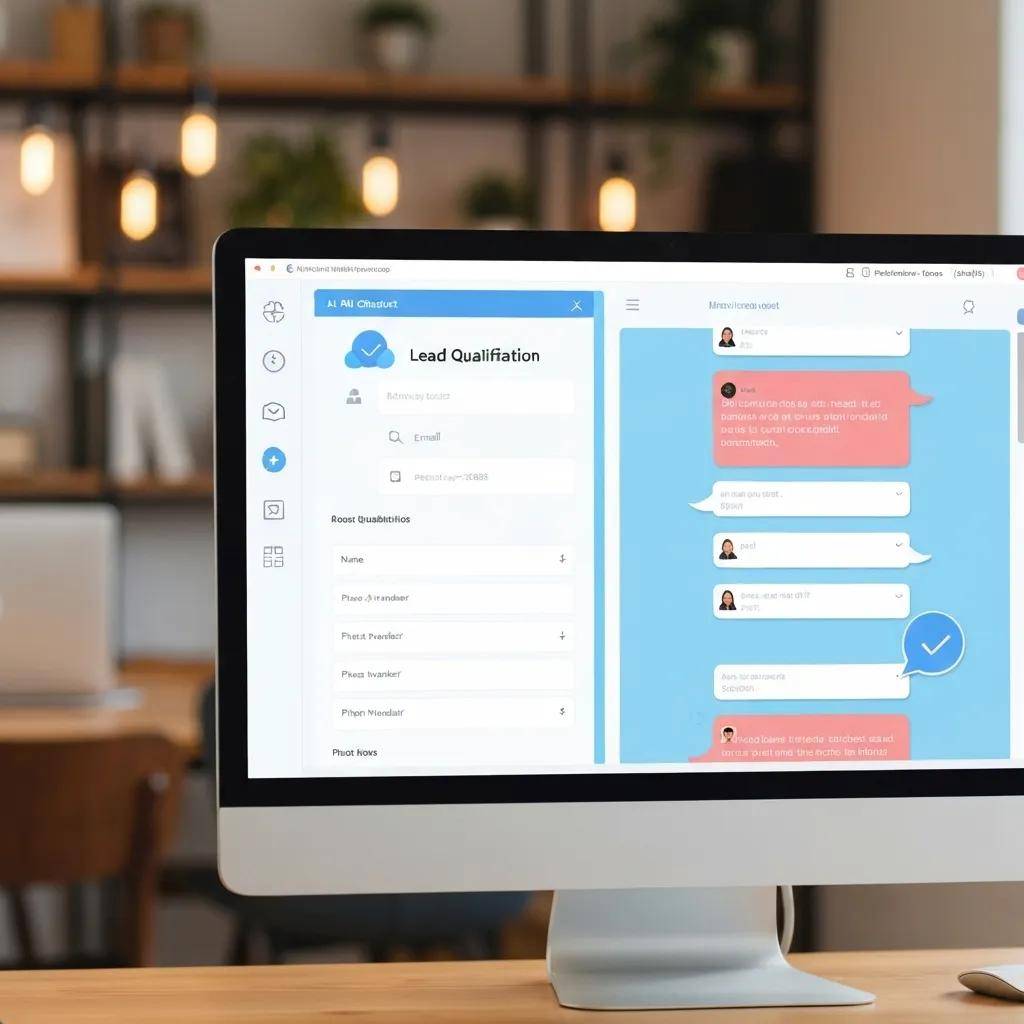Here are five meta titles that follow your guidelines:

AI Lead Capture Examples and Use Cases: Proven Strategies and Tools for Business Growth
Artificial intelligence is revolutionizing how businesses capture, qualify, and convert leads. Companies leveraging AI for lead scoring are reporting a significant 50% surge in qualified prospects and a 30% acceleration in response times. AI Lead Capture utilizes sophisticated algorithms to engage website visitors, analyze their behavior, and deliver precisely tailored content designed to convert interest into tangible action. This comprehensive guide unveils practical AI lead capture examples, outlines the core benefits, presents strategic frameworks, and recommends essential tools to empower SMBs in scaling their revenue and streamlining their sales processes.
Inside, you’ll uncover:
- A clear definition of AI Lead Capture and its critical importance for today’s businesses
- Real-world applications, from intelligent chatbots to sophisticated cold outreach
- A practical, step-by-step strategy for seamless AI integration
- A curated selection of top AI tools, crucial ethical considerations, and transformative B2B applications
What Is AI Lead Capture and Why Is It Essential for Modern Businesses?
AI Lead Capture employs machine learning and natural language processing to automate visitor interactions, intelligently qualify prospects based on their behavior, and efficiently route high-value leads to sales teams. This results in significantly faster follow-ups and demonstrably higher conversion rates. Grasping this fundamental concept is key to unlocking the potential of every subsequent strategy and example presented.
AI-Driven Sales Automation: Enhancing Lead Generation and Customer Engagement
This research paper explores how Artificial Intelligence, utilizing machine learning, predictive analytics, and natural language processing, is transforming sales automation. It highlights AI’s capability to identify high-potential leads, personalize interactions, and optimize sales strategies, thereby enhancing targeting precision, reducing manual effort, and increasing conversion rates.
This academic paper directly supports the article’s foundational explanation of AI Lead Capture, its core benefits, and how AI technologies drive effective lead capture through automated qualification, personalized engagement, and improved conversion rates.
How Has Lead Generation Evolved with AI Technologies?
Lead generation has transformed from static web forms and manual data entry into dynamic, conversational experiences powered by AI. While early methods relied on basic form submissions, modern AI chatbots now analyze visitor inquiries, assess intent, and automatically schedule follow-up appointments. This evolution has dramatically boosted efficiency, allowing sales teams to concentrate solely on high-potential prospects, leading to optimized resource allocation and a superior return on investment.
What Are the Core Benefits of AI-Powered Lead Capture?
Efficient AI capture delivers tangible advantages through:
- Automated Qualification – Real-time analysis of visitor intent significantly reduces the need for manual screening.
- Personalized Engagement – Tailored messaging dynamically adapts to individual needs and observed behavior.
- Scalable Outreach – Intelligent bots can manage an unlimited volume of interactions, operating 24/7.
- Data-Driven Insights – Predictive analytics pinpoint top-tier leads, enabling strategic prioritization.
These combined benefits work to lower acquisition costs and elevate conversion rates, setting the stage for selecting the most impactful technologies.
Which AI Technologies Drive Effective Lead Capture?
AI lead capture relies on three foundational technologies:
- Machine Learning Models that predict prospect value by analyzing historical data and real-time behavioral patterns.
- Natural Language Processing (NLP) engines that interpret visitor questions and respond in a natural, conversational manner.
- Robotic Process Automation (RPA) workflows that automatically integrate captured leads into CRM systems.
Collectively, these technologies forge a seamless lead funnel that captures, enriches, and routes prospects with minimal human intervention, preparing businesses for advanced, high-impact use cases.
What Are the Most Effective AI Lead Capture Examples and Use Cases?
AI lead capture demonstrates its immense value across a diverse range of applications, with each use case illustrating how intelligent automation effectively converts engagement into qualified leads.
How Do AI Chatbots Automate Lead Qualification and Engagement?

AI chatbots leverage NLP to guide visitors through dialogues designed to uncover intent, qualifying prospects with precisely targeted questions. These chatbots can instantly assess factors like industry, role, and specific needs, then score visitors against predefined criteria. By efficiently handling FAQs, scheduling demos, and capturing contact details without requiring human input, chatbots maintain high engagement levels and free up sales teams for more complex, high-touch interactions.
To implement chatbots effectively:
- Strategically deploy them on pages with high visitor traffic.
- Develop qualification questions that align perfectly with your buyer personas.
- Integrate chatbot data directly with your CRM for seamless follow-up processes.
This conversational approach naturally leads into predictive lead scoring for optimizing outreach prioritization.
What Are Predictive Lead Scoring Use Cases in Sales Prioritization?

Predictive lead scoring utilizes machine learning to rank prospects based on their likelihood to convert, enabling sales representatives to focus their efforts on leads with the highest closing potential. The model’s inputs encompass firmographic data, website behavior, email engagement metrics, and historical conversion patterns.
Here’s a comparison of common predictive scoring use cases:
| Use Case | Mechanism | Outcome |
|---|---|---|
| Website Behavior Scoring | Analyzes page visits, time spent on site, and content downloads | Identifies high-interest leads in real time |
| Email Engagement Prediction | Tracks open rates, link clicks, and response times | Prioritizes follow-ups based on engagement signals |
| CRM Data Enrichment | Integrates external firmographic and technographic data | Improves model accuracy and overall lead quality |
Each of these use cases accelerates risk reduction by clearly highlighting top-tier prospects, preparing businesses to deliver highly personalized content and outreach.
The Future of Lead Scoring: How AI is Transforming B2B Marketing Trends in 2025 and Beyond
This article highlights that companies leveraging AI-powered lead scoring have experienced an average 25% increase in conversion rates, according to a study by Marketo. It emphasizes AI’s role in enhancing accuracy, efficiency, and personalization within B2B marketing strategies.
This information provides a verifiable statistic that supports the article’s claims about the measurable gains from AI-powered lead capture, specifically regarding increased conversion rates and improved efficiency through predictive lead scoring.
How Does AI-Powered Content Personalization Improve Lead Engagement?
AI content engines meticulously analyze visitor attributes and behavior to dynamically deliver personalized web pages, email offers, and product recommendations. This real-time personalization significantly boosts relevance and increases time spent on site, thereby raising the probability of form submissions. For instance, a returning visitor might be presented with case studies relevant to their industry, while a new lead receives an introductory guide—both tailored experiences are designed to drive conversion.
How Is AI Used in Automated Cold Outreach for Lead Generation?
AI-powered outreach tools are designed to generate and dispatch personalized email and LinkedIn messages, informed by prospect profiles, past interactions, and shared connections. These platforms rigorously test subject lines, optimize send times, and conduct A/B testing on messaging to maximize response rates. Automated sequences ensure consistent follow-up, effectively minimizing human error and alleviating the burden of repetitive tasks.
By embedding AI-generated content at scale, businesses can extend their engagement beyond existing website visitors and cultivate robust pipelines from cold audiences, preparing them for a strategic integration framework.
How Can Businesses Build an AI-Powered Lead Capture Strategy?
Adopting a structured approach to strategy development is crucial for ensuring successful AI implementation, driving continuous improvement, and maximizing ROI.
What Steps Are Involved in Assessing Current Lead Generation Processes?
Begin by conducting a comprehensive audit of your existing processes to identify bottlenecks and uncover data gaps:
- Map out all current lead sources and the criteria used for qualification.
- Analyze conversion rates at every stage of your sales funnel.
- Identify manual tasks that are prime candidates for automation.
- Review your current technology integrations and data flow mechanisms.
This detailed inventory will clarify your priorities and inform the most effective AI interventions.
How Do You Identify the Right AI Integration Points?
Selecting the optimal AI solution requires aligning its capabilities with your specific business objectives:
- Lead Qualification – Implement chatbots or scoring models in areas where manual screening is causing delays in the sales process.
- Content Delivery – Deploy personalization engines on web pages that exhibit high bounce rates.
- Outreach Automation – Utilize AI sequencers when cold email or social prospecting efforts are underperforming.
- Enrichment & Analytics – Leverage predictive analytics for pipelines that currently lack actionable insights.
By connecting AI functions directly to specific pain points, companies can avoid unnecessary complexity and concentrate on areas with the highest potential impact.
Precisely identifying these integration points establishes the baseline for measuring success and guiding future iterations.
How Should Success Be Measured and AI Strategies Iterated?
Define clear Key Performance Indicators (KPIs) to rigorously evaluate the effectiveness of your AI lead capture initiatives:
- Lead Conversion Rate: The percentage of captured leads that successfully progress to become sales opportunities.
- Response Time: The average duration between a lead’s submission and the initial sales contact.
- Qualified Lead Volume: The monthly change in the number of high-value prospects generated.
- Cost per Lead: The AI investment relative to the savings achieved in acquisition costs.
Regular performance reviews and ongoing model retraining are essential for maintaining accuracy, while established feedback loops allow for the refinement of dialogues and scoring thresholds, ensuring sustained improvement.
Which AI Tools and Technologies Are Best for Sales Lead Identification?
Choosing the right software solution depends on its features, integration capabilities, and scalability to meet your specific business demands.
What Features Should You Look for in AI Lead Capture Software?
Key attributes to consider include:
- CRM Integration: Seamless bi-directional data synchronization with your existing sales platform.
- Customizable Scoring Models: The ability to adjust criteria and thresholds to match your unique needs.
- Multichannel Engagement: Support for various communication channels, including chatbots, email sequences, and live chat.
- Real-Time Analytics: Dashboards that provide clear visualization of lead behavior and scores.
- Data Enrichment: Automatic appending of crucial firmographic and intent data to lead records.
These features ensure a unified workflow that effectively captures, qualifies, and nurtures leads.
How Do Predictive Analytics and Lead Enrichment Tools Enhance Lead Quality?
Predictive analytics gathers behavioral signals and historical trends to forecast which prospects are most likely to convert. Lead enrichment platforms, in turn, append essential data points—such as company size, revenue, and technographic footprint—to incomplete lead records.
Here’s a comparison of popular solutions:
| Platform | Core Capability | Business Benefit |
|---|---|---|
| Predictive Analytics | Conversion Probability Scoring | Focuses resources on top-value prospects |
| Lead Enrichment | Data Append & Verification | Improves targeting and personalization |
The synergistic combination of advanced analytics and comprehensive enrichment elevates lead quality by ensuring that only well-qualified prospects enter your sales pipeline.
How Does CRM Integration Improve AI Lead Management?
Seamless CRM integration establishes a closed-loop system where every AI-captured lead is automatically channeled into your existing workflows. Contact details, lead scores, and engagement histories are updated in real time, eliminating manual data imports and ensuring sales representatives have complete context. This unified view accelerates follow-up actions, minimizes data silos, and maintains compliance by centralizing all lead records.
What Are Real-World AI Lead Capture Success Stories and Case Studies?
Case studies offer compelling proof of concept and showcase the measurable results achieved by businesses that have successfully implemented AI lead capture solutions.
How Have SMBs Increased Qualified Leads Using AI Chatbots?
A small to medium-sized business in the professional services sector deployed a conversational AI widget designed to ask qualifying questions and recommend relevant resources. Within just three months, the company experienced a remarkable 40% increase in demo requests and a 25% reduction in lead qualification time. The chatbot’s consistent performance and 24/7 availability were instrumental in fueling this rapid growth, effectively engaging visitors outside of standard business hours and ensuring no inquiry went unanswered, thereby paving the way for predictive scoring deployments.
What Results Have Businesses Achieved with Predictive Lead Scoring?
A mid-sized software firm adopted a machine learning model that analyzed six months of CRM data and web session logs. The model successfully identified key behavioral patterns, resulting in a significant 50% increase in marketing-qualified leads and a 20% uplift in closed deals. Predictive scoring empowered sales representatives to prioritize the most promising leads, drastically reducing average response times from 48 hours to under two hours and driving substantial revenue growth.
How Does Merkad Agency Support AI Lead Capture Implementation?
Merkad Agency provides expert guidance to businesses throughout every phase of AI implementation—from initial strategy design and data preparation to model deployment and ongoing optimization. Our proven methodology expertly blends industry best practices with customized predictive scoring, chatbot configuration, and seamless CRM integration. To discover more about our comprehensive AI solutions and explore our client success stories, please visit AI – Merkad Agency. This strategic partnership ensures rapid time to value and continuous improvement, perfectly aligned with your growth objectives.
What Ethical Considerations Should Businesses Address in AI Lead Capture?
Responsible AI lead capture requires a careful balance between embracing innovation and upholding data privacy and transparency, thereby safeguarding both your business reputation and legal compliance.
How Does Responsible AI Use Impact Data Privacy and Compliance?
AI systems must rigorously adhere to regulations such as GDPR, CCPA, and others by obtaining explicit consent before collecting any personal data. Data retention policies should be clearly communicated, and automated decisions necessitate human oversight to prevent potential biases. Implementing straightforward opt-out mechanisms and ensuring robust encryption of user data are crucial for preserving trust and minimizing legal exposure.
What Are Best Practices for Transparent AI Lead Generation?
Businesses should commit to the following:
- Clearly disclose the use of AI chatbots and automated scoring processes.
- Provide easily accessible privacy notices and detailed explanations of data usage.
- Offer straightforward options for prospects to update or delete their personal information.
- Maintain accessible human escalation paths for addressing complex inquiries.
These measures are vital for fostering trust, demonstrating respect for prospect rights, and cultivating long-term relationships as AI tools become increasingly integrated into business operations.
How Is AI Transforming B2B Lead Generation Strategies?
Within B2B environments, AI significantly enhances prospecting precision, sales intelligence, and the personalization of outreach efforts, elevating them to unprecedented levels.
What Role Does AI Play in B2B Prospecting and Sales Intelligence?
AI aggregates data from a multitude of sources—including public filings, social media platforms, and historical interaction records—to construct comprehensive prospect profiles. Subsequently, machine learning models score both companies and individual contacts, identifying high-potential accounts for targeted account-based marketing campaigns. This data-driven methodology replaces generic lead lists with precisely targeted prospect lists, leading to substantially higher engagement rates.
How Do AI-Powered Sales Engagement Platforms Enhance Outreach?
Platforms equipped with AI capabilities automate the creation of outreach sequences, facilitate the testing of various messaging approaches, and recommend the optimal next actions for each individual prospect. They continuously monitor open and reply rates in real time, dynamically adjusting cadences and content to maximize results. Automated logging and comprehensive analytics ensure that every interaction is meticulously tracked, enabling the continuous refinement of outreach strategies.
What Are Examples of AI Tools Specifically Designed for B2B Lead Capture?
Leading B2B AI solutions include:
- Conversational Bots specifically engineered for enterprise-grade security and multi-language support.
- Predictive Marketplaces that effectively match buyer intent signals with in-house product or service offerings.
- Sales Intelligence Suites that integrate data enrichment, intent data, and CRM connectors for a unified view.
Each of these tools is designed to address distinct B2B requirements, ranging from global compliance standards to deep firmographic insights, thereby preparing organizations for targeted, efficient pipeline growth.
The rapid advancements in AI continue to redefine how businesses attract and convert prospects. Those organizations that embrace these proven examples and use cases will undoubtedly secure a significant competitive advantage. Companies that effectively harness AI Lead Capture experience accelerated qualification, gain deeper customer insights, and achieve improved conversion rates—all critical elements for sustained growth in today’s digital landscape. If you’re prepared to elevate your lead generation efforts with intelligent automation, the optimal time to take action is now.
